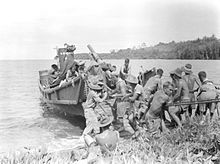
The 7th Division was an infantry division of the Australian Army. It was formed in February 1940 to serve in World War II, as part of the Second Australian Imperial Force. The division was raised on the British establishment of nine infantry battalions per division and consisted of two new brigades and three of the original 12 battalions of the 6th Division forming the third brigade. The division is sometimes known by the nickname "The Silent Seventh", due to a perception that its achievements were unrecognised, in comparison to the other Australian divisions. The origin of this belief appears to be censorship of the part played by the 7th Division in the fierce fighting in the 1941 Syria-Lebanon campaign. The 7th Division along with the 6th and 9th Australian Divisions were the only divisions to serve in both the Middle East and the South West Pacific Area. It was disbanded in 1946, following the end of the war.

I Corps was an Australian Army corps, one of three that were raised by the Army during World War II. It was the main Australian operational corps for much of the war. Various Australian and other Allied divisions came under its control at different times. In 1940–1942, the corps was based in the Mediterranean and Middle Eastern theatres, and controlled forces in action against the Germans, Italians and later the Vichy French in North Africa, Greece and Syria–Lebanon.

The 18th Brigade was an infantry brigade of the Australian Army. The brigade briefly existed as a Militia formation prior to the First World War, but this was short-lived. During the Second World War, the brigade was raised on 13 October 1939 and was one of the first three infantry brigades of the Second Australian Imperial Force to be formed. Initially commanded by Brigadier Leslie Morshead, it served in the United Kingdom in 1940–1941, where it helped bolster the British garrison in anticipation of a possible German invasion following the Fall of France. In early 1941, the brigade was transferred to the Middle East where it later took part in fighting against the Italians in Libya and then helped to defend the besieged port of Tobruk before fighting against the Vichy French in the Syria–Lebanon campaign. The 18th Brigade was withdrawn to Australia in early 1942, and it later took part in the fighting against the Japanese in Pacific fighting several campaigns in New Guinea between late 1942 and early 1944. Its final involvement of the war came in mid-1945 when it took part in re-taking Balikpapan. Following the end of hostilities, the 18th Brigade was disbanded on 3 January 1946.

The 2/4th Field Regiment was an Australian Army artillery regiment formed on 2 May 1940, as part of the 7th Division during World War II. The regiment was involved in campaigns in North Africa, Syria–Lebanon, Salamaua–Lae, the Finisterre Ranges and Borneo. After training in Victoria, the regiment deployed to North Africa in late 1940. After being deployed in the defence of Mersa Matruh in Egypt in early 1941, the regiment took part in the fighting against the Vichy French in Syria and Lebanon, before undertaking garrison duties there. It returned to Australia in early 1942 following Japan's entry into the war, and in September 1943, a small group of artillerymen from the 2/4th parachuted with two short 25 Pounder guns in the airborne landing at Nadzab airstrip in New Guinea in support of the U.S. Army's 503rd Parachute Infantry Regiment. Later, the regiment took part in the 7th Division's advance through the Finisterre Range before returning to Australia in early 1944. Its final involvement in the war came around Balikpapan in 1945. After the war, the regiment was disbanded on 7 February 1946.
The 2/7th Cavalry (Commando) Regiment was one of three commando regiments raised by the Australian Army for service during World War II. It was originally raised as the 7th Division Cavalry Regiment in 1940 and in this guise it served in North Africa and the Middle East at the beginning of the war, before it was brought back to Australia and sent to New Guinea in late 1942 to serve against the Japanese. In mid-1943 the Australian high command decided to disband the divisional cavalry regiments and use their headquarters elements to administer the independent companies that had been raised earlier in the war. In the process the 7th Division Cavalry Regiment disbanded its squadrons, gave up their vehicles and changed its name to the 2/7th Cavalry (Commando) Regiment, as it became the administrative headquarters for the 2/3rd, 2/5th and 2/6th Commando Squadrons.

The 2/31st Battalion was an infantry battalion of the Australian Army that served during World War II. It was raised in June 1940 and was assigned to the 25th Brigade, 7th Division. It initially served in the United Kingdom where it undertook defensive duties before being moved to the Middle East in 1941. After taking part in the fighting in Syria and Lebanon, the battalion undertook garrison duties around Tripoli before being transferred back to Australia in 1942. In late 1942 the battalion was sent to New Guinea to fight against the Japanese along the Kokoda Track. They subsequently fought a number of battles throughout 1942, 1943 and early 1944. Their last campaign came in mid-1945 when they landed on Borneo. After the war the battalion was disbanded in March 1946.
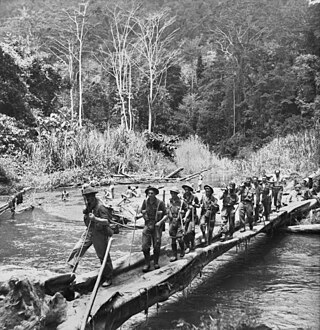
The 25th Brigade was a brigade-sized infantry unit of the Australian Army that served during the Second World War. Raised in July 1940 and consisting of three infantry battalions, the 25th Brigade initially served in the United Kingdom, where it formed part of the garrison tasked with defending against a possible German invasion. In 1941, the brigade was redeployed to the Middle East where it took part in the Syria–Lebanon campaign fighting several actions around Merdjayoun and Jezzine.
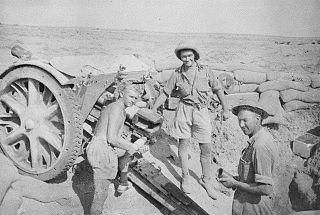
The 2/12th Field Regiment was an Australian Army artillery regiment formed as part of the all volunteer Second Australian Imperial Force for overseas during World War II. Recruited in the state of Victoria in early 1940, the 2/12th was initially formed as a medium artillery regiment, but was later converted to a field regiment due to a lack of medium guns. As a field regiment, the 2/12th deployed to the Middle East where they supported the 9th Division in several battles during the North African Campaign in 1941–42, and undertook garrison duty in Lebanon. In early 1943, the regiment returned to Australia and subsequently fought in New Guinea, seeing action against the Japanese during the Huon Peninsula Campaign in 1943–44 and then the Borneo Campaign in 1945.

The 2/1st Field Regiment was an Australian Army artillery regiment raised as part of the all volunteer Second Australian Imperial Force during World War II. Formed in October 1939, the regiment was assigned to the 6th Division. Shortly after it was raised, the regiment was deployed to the Middle East, where it was briefly re-roled as an anti-aircraft regiment before returning to the field artillery role. In 1941, the regiment served in North Africa and in Greece, before being withdrawn back to Australia in early 1942, following Japan's entry into the war. In late 1942, and early 1943, the regiment took part in the defence of Port Moresby during the fighting along the Kokoda Track, before taking part in the Battle of Buna–Gona and the defence of Wau, remaining in New Guinea on garrison duties until August 1943. Withdrawn to Australia, a long period of training followed before the regiment took part in its final campaign of the war Aitape–Wewak campaign in 1945.

The 2/3rd Field Regiment was an Australian Army field artillery regiment that was raised for service during the Second World War. Formed in 1939 and assigned to the 6th Division, the regiment was deployed to the United Kingdom to defend against a possible invasion in 1940 before being sent to North Africa, where it briefly saw action prior to being sent to Greece and Crete in 1941. In 1942, the regiment returned to Australia, after which it did not see action again until late in the war when it was committed to the Aitape–Wewak campaign in 1944–45. Following the end of the war, the regiment returned to Australia and was disbanded in January 1946.

The 2/7th Field Regiment was an Australian Army field artillery regiment that served during the Second World War. Formed in mid-1940 and assigned to the 9th Division, the regiment was deployed to North Africa, where it saw action around Tobruk in 1941 and in the First and Second Battles of El Alamein in 1942. It also undertook garrison duties in Syria and Egypt. In 1943, the regiment returned to Australia, after which it did not see action again until late in the war when it was committed to the landing at Tarakan in 1945. Following the end of the war, the regiment returned to Australia and was disbanded in January 1946.

The 2/2nd Field Regiment was an Australian Army field artillery regiment that was raised for service during the Second World War. Assigned to the 6th Division, the regiment was formed from Second Australian Imperial Force volunteers. Raised in October 1939, the regiment undertook basic training in Australia before departing for the Middle East in mid-1940. Further training was undertaken in Egypt, before the regiment saw action in the Western Desert in early 1941, and in Greece and on Crete in the middle of the year. Later, they provided a defensive garrison on Ceylon in mid-1942 before returning to Australia. It did not see further action until the final phase of the war, when it was deployed to Aitape–Wewak, fighting against the Japanese, in 1944–1945. It was disbanded in January 1946, after returning to Australia for demobilisation.

The 2/8th Field Regiment was an Australian Army field artillery regiment that was raised for service during the Second World War as part of the all-volunteer Second Australian Imperial Force. Composed mainly of soldiers from the states of Victoria and Tasmania, the regiment was one of three field artillery regiments that were assigned to the Australian 9th Division during the war, and during its war service it saw action in North Africa in 1941–42, being heavily involved in the First and Second Battles of El Alamein between July and November 1942 before returning to Australian in 1943, as the Australian government rebalanced its land forces to face the threat in the Pacific. Nevertheless, the regiment did not see action again until mid-1945 when it was committed to the brief Borneo campaign. It was disbanded in early 1946 at the conclusion of hostilities.

The 2/6th Field Regiment was an Australian Army artillery regiment formed as part of the 7th Division in May 1940 for operations during World War II. The regiment served in Egypt and Syria in 1941–1942 before returning to Australia after Japan's entry in the war. Throughout 1943 and 1944, the regiment served against the Japanese in New Guinea. The regiment's involvement in the fighting in New Guinea saw it committed to several campaigns, including those around Salamaua and on the Huon Peninsula. Its final campaign of the war was fought on Borneo in mid-1945. Shortly after the conclusion of hostilities, the regiment was disbanded in late 1945.
The 2/9th Field Regiment was an Australian Army artillery regiment formed as part of the all volunteer Second Australian Imperial Force in July 1940 for operations during World War II. Assigned to the 1st Australian Corps, the regiment was sent to the Middle East in mid-1941, and served in Palestine, Egypt, and Syria before returning to Australia in 1942. It undertook defensive duties in south-east Queensland before deploying north to Merauke, in Dutch New Guinea, and Cape York. It returned to Australia in October 1944 and sent to the Atherton Tablelands to carry out training as it waited for further deployment. This never came and the regiment was disbanded in late 1945.
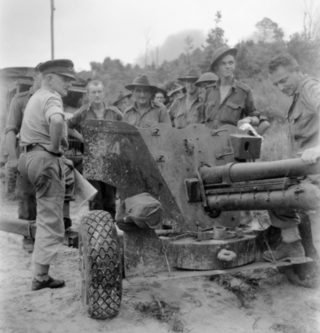
The 2/2nd Anti-Tank Regiment was an Australian Army anti-tank artillery regiment that was raised for service during the Second World War. Formed in 1940 in Brisbane, Queensland, the regiment was assigned to the 7th Division and was deployed to North Africa in 1940, and subsequently undertook defensive duties in Egypt in 1941, before taking part in the Syria–Lebanon campaign. Garrison duties were undertaken in Syria, before the regiment was back to Australia in early 1942. It later fought against the Japanese in New Guinea and on Borneo before being disbanded in 1946.
The 9th Regiment, Royal Australian Artillery is an artillery regiment of the Australian Army. It draws lineage from an artillery unit raised in 1903, which provided personnel to artillery units raised for service during World War I seeing action on the Western Front. It was mobilised for service during World War II and undertook defensive duties in Australia before being disbanded in 1944. The regiment was re-raised as part of the Australian Army Reserve in 2018, and currently provides artillery support to the 2nd Division. It consists of six light batteries, which are based at numerous depots around the country. The regiment's headquarters is based in Sydney, New South Wales.
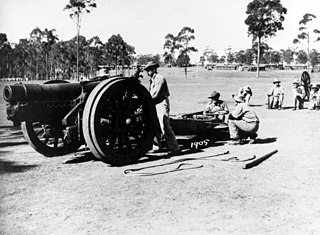
The 2/1st Medium Regiment was an artillery regiment of the Australian Army during World War II. Raised in 1940 as part of the all volunteer Second Australian Imperial Force, the regiment undertook garrison duties in Australia, Nauru and on Ocean Island, and served in the Middle East. It was converted to a field regiment, designated the 2/13th Army Field Regiment, due to a lack of howitzers, but was later converted back into a medium regiment. During 1943–1944, the regiment served as the 2/13th Composite Anti Aircraft Regiment before returning to the medium role. It was disbanded in July 1945, in Queensland.

The 2/1st Anti-Tank Regiment was an Australian Army anti-tank artillery regiment that was raised for service during the Second World War as part of the all volunteer Second Australian Imperial Force. Formed in November 1939, it was sent to the United Kingdom in mid-1940, but was broken up and converted into infantry. In late 1940, the regiment was re-formed and deployed to the Middle East, joining the 6th Division. It took part in the Battle of Greece before being evacuated to Egypt. Later, the regiment took part in the Syria–Lebanon campaign. In early 1942, it was withdrawn back to Australia for service in the Pacific. En route the regiment was diverted to Ceylon for garrison duties. It served in New Guinea around Port Moresby and Milne Bay in 1942–1943 and then again in early 1945 during the Aitape–Wewak campaign, serving there until the end of the war.
The 23rd Regiment, Royal Australian Artillery was an Australian Army artillery regiment of the Australian Army. Raised in 1948 as a Citizen Military Forces anti-tank unit designated the 3rd Anti-Tank Regiment, it was converted to a field artillery regiment in the 1950s. It supported the 5th Brigade until being reduced to a battery-sized sub unit, and assigned to the 9th Regiment, Royal Australian Artillery in 2018.
